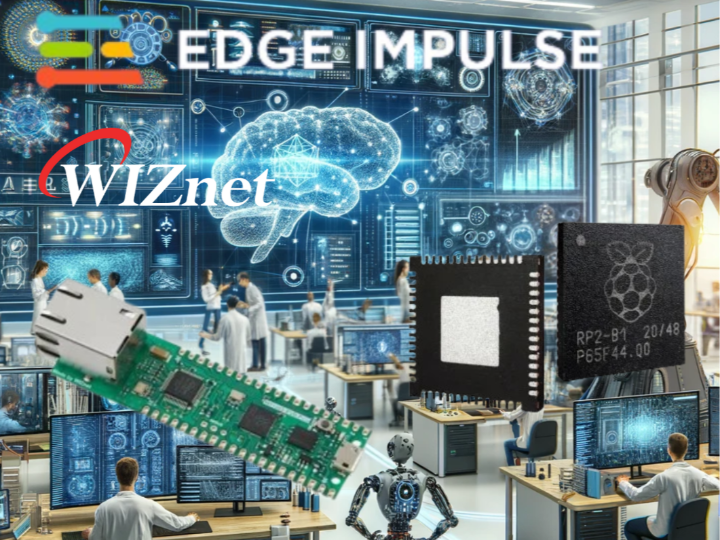TinyML on RP2040 with Edge Impulse
Machine learning and data handling as demonstrated by the Raspberry Pi RP2040, facilitated by Edge Impulse.

Software Apps and online services
The W5500-EVB-Pico board, equipped with WIZnet's W5500 Ethernet chip, offers a robust platform for developing Internet of Things (IoT) applications. Like the Raspberry Pi RP2040, the W5500-EVB-Pico can be seamlessly integrated with Edge Impulse, a leading platform for developing machine learning (ML) models. This integration enables users to leverage the full capabilities of machine learning directly from the Edge Impulse Studio, enhancing the functionalities of IoT projects.
Getting Started with the W5500-EVB-Pico and Edge Impulse
1. Prepare Your Development Board: Ensure you have a W5500-EVB-Pico board. This board, while fundamentally similar to the Raspberry Pi Pico in utilizing the RP2040 microcontroller, includes the additional feature of onboard Ethernet connectivity, enhancing its capability for IoT projects.
2. Software Installation:
- Edge Impulse CLI: First, install the Edge Impulse command line interface (CLI) to facilitate communication between your development board and the Edge Impulse platform.
- Serial Communication Program: For interacting with the board, you might need a serial communication program such as minicom or picocom, or you can use the Serial Monitor from the Arduino IDE. On Linux systems, you can use GNU Screen, installed via sudo apt install screen.
3. Connecting the Board:
- Enter USB Mass Storage Mode: Connect your W5500-EVB-Pico to your computer using a micro-USB cable. This connection might differ slightly based on whether the W5500-EVB-Pico has a dedicated BOOTSEL button or an alternative method for entering USB Mass Storage Mode.
- Flash the Firmware: Download the appropriate Edge Impulse firmware tailored for RP2040-based boards. You might need to adapt the firmware for the specific configurations and capabilities of the W5500-EVB-Pico, especially regarding its Ethernet functionalities.
- Upload and Configure Firmware: Drag and drop the firmware file onto the board mounted as a USB drive, then restart the board to launch the new firmware.
4. Setting Up Edge Impulse:
- Run Edge Impulse Daemon: Execute edge-impulse-daemon from your terminal to set up and connect the board to your Edge Impulse account. Follow the prompts to log in and select or create a new project.
- Data Collection: Depending on your project's needs, connect various sensors to your W5500-EVB-Pico. You can leverage the Ethernet capability for remote data collection and management.
Building and Deploying ML Models:
- Sensor Integration: Like the Raspberry Pi Pico setup, integrate sensors that are relevant to your project, such as temperature, humidity, motion, or environmental sensors. Ensure these sensors are compatible with the GPIO pin configuration of the W5500-EVB-Pico.
- Model Training: Use Edge Impulse Studio to train machine learning models based on the data collected from the sensors connected to your W5500-EVB-Pico.
- Deploy and Infer: Once trained, deploy these models back to the W5500-EVB-Pico to perform real-time data inference.



